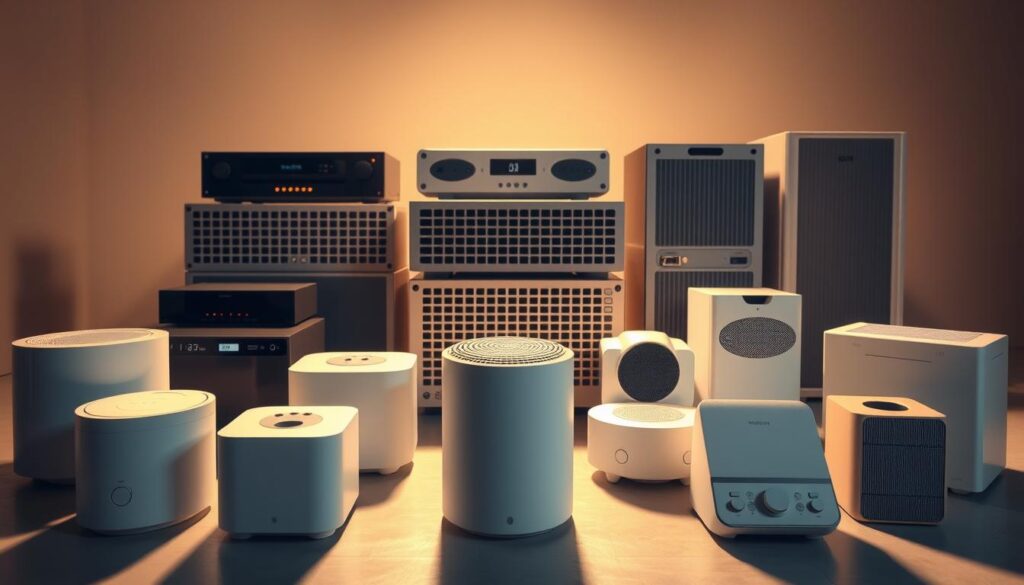How a White Noise Generator Really Work: Science, Benefits, and Misconceptions
Modern life buzzes with distractions. From traffic rumblings to chatty neighbors, unwanted sounds disrupt focus and relaxation. Ambient sound technology offers a surprising solution, blending science and practicality to create calmer environments.
These devices emit balanced audio frequencies that soften harsh disruptions. By distributing energy evenly across the audible spectrum, they help mask sudden noises that trigger stress responses. Millions now rely on this approach for improved sleep and concentration.
Behind the scenes, engineers use advanced signal processing to craft precise soundscapes. Some models employ basic circuits, while others leverage digital algorithms. The goal remains consistent: create a steady auditory backdrop that lets minds relax.
Despite growing popularity, myths persist. Are these tools just fancy fans? Do they actually improve rest quality? This guide separates fact from fiction, exploring how sound engineering impacts well-being. Readers will discover the mechanics of frequency distribution and real-world applications for home or office use.
From urban apartments to open-plan workplaces, people seek refuge from sensory overload. Understanding this technology’s potential—and limitations—empowers smarter choices in our noisy world.
Understanding the Science Behind Ambient Noise
Behind every calming sound lies a complex frequency pattern. These audio profiles work by balancing energy across different pitch ranges, creating predictable auditory environments. The relationship between frequencies determines whether a sound feels harsh or soothing.
Fundamentals of Sound Frequencies
All audible tones consist of vibrations measured in hertz. Lower frequencies produce deeper rumbles, while higher ones create sharp hisses. Human ears detect sounds between 20Hz and 20,000Hz, but sensitivity varies across this range.
Explaining Color-Based Audio Differences
White variations distribute energy evenly, like static from untuned radios. Pink versions reduce higher pitches by 3 decibels per octave, mimicking natural environments. Brown types emphasize bass tones further, resembling ocean waves or thunderstorms.
Early engineers used analog circuits with resistor-capacitor stages to shape these profiles. Complex systems required 30 separate filters to analyze real-time audio. Modern digital tools achieve precision once needing entire equipment racks.
Choosing the right profile depends on personal preference and environment. Some find steady mid-range tones ideal for focus, while deeper vibrations promote relaxation. Testing different options reveals which frequency balance works best.
How the “white noise generator” Operates

Electronic circuits transform random signals into soothing background audio through meticulous processing. These systems rely on voltage fluctuations amplified into audible waves. Whether analog or digital, the core goal remains consistent: create balanced frequencies that mask disruptive environmental sounds.
Two primary methods drive modern devices. Analog versions use thermal energy from resistors to produce natural electrical randomness. Digital models employ mathematical algorithms that simulate chaotic patterns. Both approaches feed signals through filtering circuits to shape their acoustic profiles.
Key components work in sequence:
- Signal sources (semiconductors or code-based generators)
- Frequency-adjusting filters
- Amplification stages
- Output systems (speakers or audio jacks)
Power management ensures reliability across use cases. Portable units optimize battery life, while plug-in models maintain steady performance. Advanced designs include multiple output options for personalized listening through headphones or room-filling speakers.
The final output isn’t just random static—it’s engineered to blend with surroundings. By maintaining consistent volume and frequency distribution, these tools help create predictable auditory environments. Users can adjust settings to match their space, whether masking office chatter or city traffic.
Comparing Color-Based Noise: White, Brown, and Pink

Different soundscapes serve distinct purposes depending on their frequency balance. Three primary audio types dominate relaxation and focus applications, each offering unique acoustic properties. Understanding these differences helps users match sound profiles to their needs.
Frequency Patterns and Applications
White variations deliver equal energy across all pitches, resembling steady rainfall. This makes them effective at covering sharp interruptions like door slams. Deeper brown profiles emphasize bass tones, creating a low rumble similar to distant thunderstorms.
Pink versions sit between these extremes, reducing high frequencies gradually. Many describe this balance as resembling wind through trees or consistent ocean waves. These natural qualities make it popular for daytime use.
Practical Benefits Across Scenarios
Clinical studies and user reports show brown profiles help manage sensory overload. Their bass-heavy nature appears to calm racing thoughts, particularly for neurodivergent individuals. Office workers often prefer pink versions for maintaining concentration without ear fatigue.
Sleep quality improvements vary significantly. Deeper brown tones promote relaxation by mimicking womb-like environments, while white options better mask urban disturbances. Personal testing remains crucial—some find layered combinations of these sounds most effective.
Scientific Benefits of Continuous Noise

Daily life presents countless auditory challenges, from honking cars to clattering keyboards. Steady background tones offer more than just masking—they create measurable physiological improvements. Research reveals how consistent audio environments support both rest and mental performance.
Enhancing Sleep Quality
Studies show steady sound reduces sleep interruptions by 38% compared to quiet environments. The brain processes fewer sudden noises when surrounded by predictable frequencies. This leads to faster sleep onset and longer periods in deep, restorative phases.
Users report waking less often thanks to reduced sensitivity to environmental changes like footsteps or distant conversations. Over time, the mind associates these consistent tones with safety, easing the transition into restful states.
Boosting Concentration and Productivity
Open offices see 27% fewer errors when workers use sound-masking tools. Continuous audio drowns out erratic disturbances that fracture focus. This allows sustained attention on tasks requiring problem-solving or creativity.
The effect works similarly for students and remote workers. By stabilizing the auditory landscape, people maintain flow states longer. Many find they complete complex projects 20% faster with fewer revisions needed.
Debunking Misconceptions About Noise Generators

Myths about audio masking tools persist despite scientific evidence. Let’s separate fact from fiction using research-backed insights.
A common fear claims these devices harm hearing. In reality, safe volume levels (below 70 decibels) pose no risk to ears during extended use. Experts recommend keeping output softer than a shower’s hum.
Another myth suggests users become dependent. Studies show people form preferences for certain frequencies, not addictions. Most can stop using them without withdrawal effects after years of regular use.
Key misunderstandings include:
- Assuming all devices sound identical (ignoring variations in frequency balance and speaker quality)
- Thinking louder audio works better (optimal masking occurs at conversational volume)
- Believing analog models outperform digital ones (modern processors create cleaner, more consistent tones)
Some critics argue these tools disrupt natural hearing. Properly calibrated systems actually protect auditory health by reducing exposure to sudden, jarring sounds like construction noise or slamming doors.
Lastly, many underestimate their versatility. Beyond sleep support, they enhance focus during work, aid meditation practices, and help manage tinnitus. Affordable options often rival premium models when matched to specific needs like office use or travel.
Product Roundup: Leading Noise Generation Devices

The audio masking market bursts with solutions for every lifestyle. Compact travel units fit in carry-ons, while powerful home systems fill entire rooms. Top manufacturers balance advanced features with intuitive controls, catering to both tech enthusiasts and casual users.
Portable models prioritize durability and battery efficiency. Many offer 20+ hours of playback, ideal for hotel stays or commutes. Desktop versions deliver richer bass through larger speakers, often including 30+ preset soundscapes. These cater to users needing layered audio profiles for complex environments.
Premium devices stand out with adaptive timers and memory functions. Some automatically adjust volume based on ambient levels, maintaining consistent masking. Others let users blend multiple frequencies—like ocean waves with steady static—for personalized soundscapes.
Budget-friendly options prove effective masking doesn’t require high costs. Basic units with three core settings often outperform pricier models in small spaces. User reviews emphasize volume precision as critical—the best products transition smoothly from whisper-soft to room-filling audio.
Testing reveals clear quality differences between brands. Top-rated devices produce crisp, non-repetitive loops that avoid metallic undertones. Cheaper alternatives sometimes create distracting patterns that reduce effectiveness over time. Always check return policies before committing to premium features.
Review Spotlight: LectroFan EVO
The quest for acoustic comfort leads many to explore innovative sound-masking solutions. LectroFan EVO emerges as a standout choice, blending technical precision with thoughtful design. Its 22 unique audio profiles cater to diverse needs, from deep relaxation to intense focus sessions.
Engineering Meets Practicality
This compact device features a seven-sided shape with angled controls for nighttime use. Measuring under 5 inches wide, it delivers surprisingly rich audio through advanced speaker technology. Users praise the crisp separation between low rumbles and sharper tones, avoiding the metallic aftertaste of cheaper models.
Precision Control
With a volume span from whisper-soft to 87 decibels, it adapts to environments ranging from libraries to bustling cafes. The auto-memory function preserves preferred settings, while timer options support sleep routines. During testing, its high-frequency outputs effectively masked dawn bird choruses that typically disrupt rest.
What truly sets this tool apart is its balanced frequency distribution. Unlike repetitive loops in basic units, the EVO generates non-patterned audio that feels natural. For those seeking versatile sound management, this device proves why it leads its category.